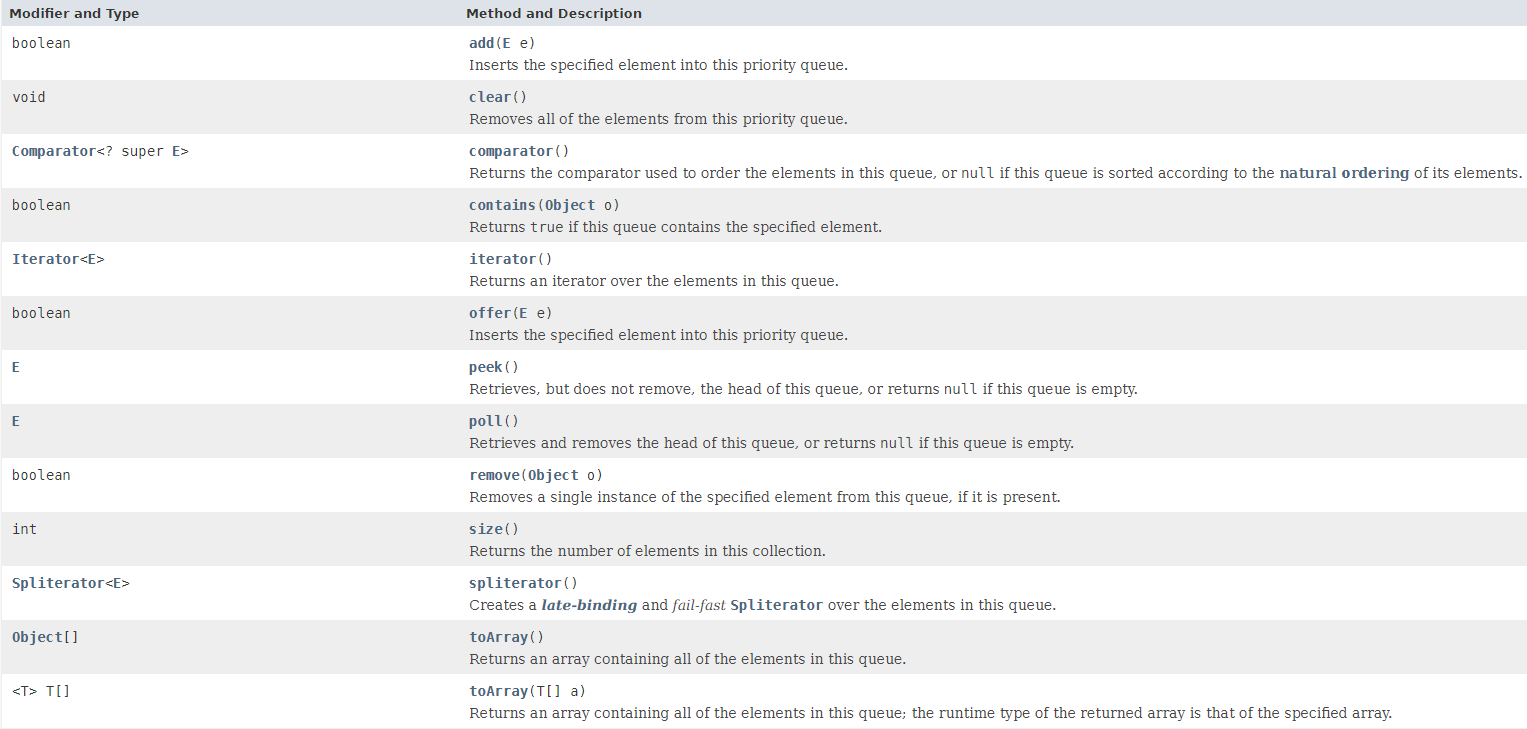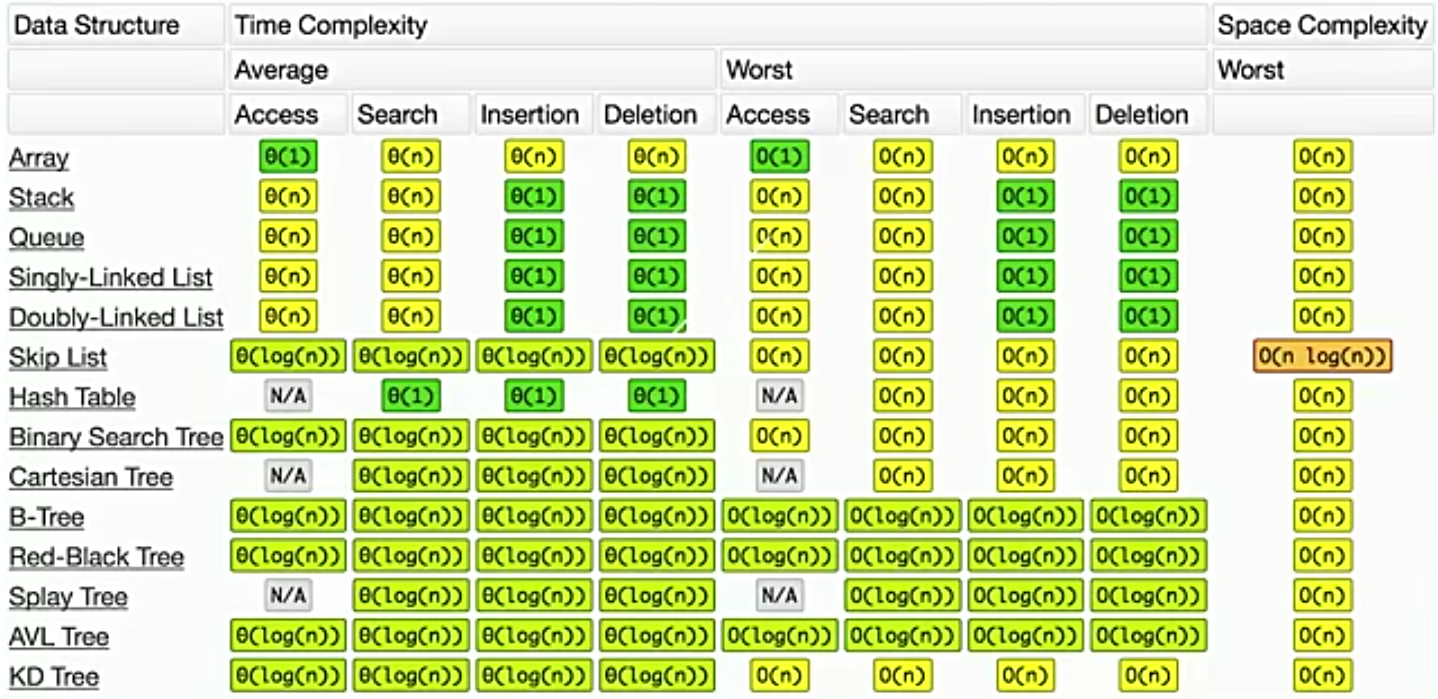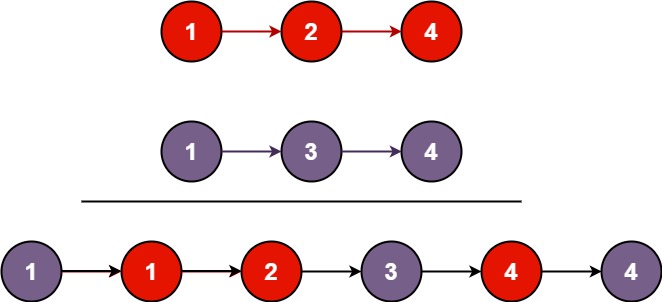-
Stack
extends class Vector
Stack<T> stack = new Stack<>();API:
empty() peek() pop() push(E item) search(Object o)Recommended in practice:
Deque<T> stack = new ArrayDeque<T>(); -
Queue
not a class, is a interface | has many class
API:

-
Deque
announce:
/dek/| Double-End Queuenot a class, is a interface | has many class
API:

-
Priority Queue
implements Collection and Queue
【Time complex】Insert: O(1), Get: O(log n)
backend:heap / BST - binary search tree / treap
API:

-
Summary of common data structure operations

-
26. Remove Duplicates from Sorted Array
Given a sorted array nums, remove the duplicates in-place such that each element appears only once and returns the new length.
Do not allocate extra space for another array, you must do this by modifying the input array in-place with O(1) extra memory.
Clarification:
Confused why the returned value is an integer but your answer is an array?
Note that the input array is passed in by reference, which means a modification to the input array will be known to the caller as well.
Internally you can think of this:
// nums is passed in by reference. (i.e., without making a copy) int len = removeDuplicates(nums); // any modification to nums in your function would be known by the caller. // using the length returned by your function, it prints the first len elements. for (int i = 0; i < len; i++) { print(nums[i]); }Example 1:
Input: nums = [1,1,2] Output: 2, nums = [1,2] Explanation: Your function should return length = 2, with the first two elements of nums being 1 and 2 respectively. It doesn't matter what you leave beyond the returned length.Example 2:
Input: nums = [0,0,1,1,1,2,2,3,3,4] Output: 5, nums = [0,1,2,3,4] Explanation: Your function should return length = 5, with the first five elements of nums being modified to 0, 1, 2, 3, and 4 respectively. It doesn't matter what values are set beyond the returned length.Constraints:
0 <= nums.length <= 3 * 104-104 <= nums[i] <= 104numsis sorted in ascending order.
class Solution { public int removeDuplicates(int[] nums) { int i = 0; for (int j = 1; j < nums.length; j++) { if (nums[i] != nums[j]) { nums[++i] = nums[j]; } } return i + 1; } } -
189. Rotate Array
Given an array, rotate the array to the right by k steps, where k is non-negative.
Follow up:
- Try to come up as many solutions as you can, there are at least 3 different ways to solve this problem.
- Could you do it in-place with O(1) extra space?
Example 1:
Input: nums = [1,2,3,4,5,6,7], k = 3 Output: [5,6,7,1,2,3,4] Explanation: rotate 1 steps to the right: [7,1,2,3,4,5,6] rotate 2 steps to the right: [6,7,1,2,3,4,5] rotate 3 steps to the right: [5,6,7,1,2,3,4]Example 2:
Input: nums = [-1,-100,3,99], k = 2 Output: [3,99,-1,-100] Explanation: rotate 1 steps to the right: [99,-1,-100,3] rotate 2 steps to the right: [3,99,-1,-100]Constraints:
1 <= nums.length <= 2 * 104-231 <= nums[i] <= 231 - 10 <= k <= 105
class Solution { public void rotate(int[] nums, int k) { int len = nums.length; k = k % len; reverse(nums, 0, len - 1); reverse(nums, 0, k - 1); reverse(nums, k, len - 1); } private void reverse(int[] nums, int i, int j) { while (i < j) { int t = nums[i]; nums[i] = nums[j]; nums[j] = t; i++; j--; } } } -
88. Merge Sorted Array
Given two sorted integer arrays
nums1andnums2, mergenums2intonums1as one sorted array.The number of elements initialized in
nums1andnums2aremandnrespectively. You may assume thatnums1has a size equal tom + nsuch that it has enough space to hold additional elements fromnums2.Example 1:
Input: nums1 = [1,2,3,0,0,0], m = 3, nums2 = [2,5,6], n = 3 Output: [1,2,2,3,5,6]Example 2:
Input: nums1 = [1], m = 1, nums2 = [], n = 0 Output: [1]Constraints:
nums1.length == m + nnums2.length == n0 <= m, n <= 2001 <= m + n <= 200-109 <= nums1[i], nums2[i] <= 109
class Solution { public void merge(int[] nums1, int m, int[] nums2, int n) { int i = m - 1, j = n - 1; for (int k = m + n - 1; i >= 0 && j >= 0; k--) { nums1[k] = nums1[i] > nums2[j] ? nums1[i--] : nums2[j--]; } while (j >= 0) nums1[j] = nums2[j--]; } } -
66. Plus One
Given a non-empty array of decimal digits representing a non-negative integer, increment one to the integer.
The digits are stored such that the most significant digit is at the head of the list, and each element in the array contains a single digit.
You may assume the integer does not contain any leading zero, except the number 0 itself.
Example 1:
Input: digits = [1,2,3] Output: [1,2,4] Explanation: The array represents the integer 123.Example 2:
Input: digits = [4,3,2,1] Output: [4,3,2,2] Explanation: The array represents the integer 4321.Example 3:
Input: digits = [0] Output: [1]Constraints:
1 <= digits.length <= 1000 <= digits[i] <= 9
class Solution { public int[] plusOne(int[] digits) { int len = digits.length; int carry = 1; for (int i = len - 1; i >= 0 && carry > 0; i--) { int num = digits[i] + 1; digits[i] = num % 10; carry = num / 10; } if (carry == 0) return digits; int[] res = new int[len + 1]; res[0] = 1; return res; } } -
21. Merge Two Sorted Lists
Merge two sorted linked lists and return it as a sorted list. The list should be made by splicing together the nodes of the first two lists.
Example 1:

Input: l1 = [1,2,4], l2 = [1,3,4] Output: [1,1,2,3,4,4]Example 2:
Input: l1 = [], l2 = [] Output: []Example 3:
Input: l1 = [], l2 = [0] Output: [0]Constraints:
- The number of nodes in both lists is in the range
[0, 50]. -100 <= Node.val <= 100- Both
l1andl2are sorted in non-decreasing order.
class Solution { public ListNode mergeTwoLists(ListNode l1, ListNode l2) { ListNode res = new ListNode(); ListNode cur = res; while (l1 != null && l2 != null) { if (l1.val < l2.val) { cur.next = l1; l1 = l1.next; } else { cur.next = l2; l2 = l2.next; } cur = cur.next; } if (l1 != null) cur.next = l1; if (l2 != null) cur.next = l2; return res.next; } } - The number of nodes in both lists is in the range
-
25. Reverse Nodes in k-Group
Given a linked list, reverse the nodes of a linked list k at a time and return its modified list.
k is a positive integer and is less than or equal to the length of the linked list. If the number of nodes is not a multiple of k then left-out nodes, in the end, should remain as it is.
Follow up:
- Could you solve the problem in
O(1)extra memory space? - You may not alter the values in the list's nodes, only nodes itself may be changed.
Example 1:

Input: head = [1,2,3,4,5], k = 2 Output: [2,1,4,3,5]Example 2:

Input: head = [1,2,3,4,5], k = 3 Output: [3,2,1,4,5]Example 3:
Input: head = [1,2,3,4,5], k = 1 Output: [1,2,3,4,5]Example 4:
Input: head = [1], k = 1 Output: [1]Constraints:
- The number of nodes in the list is in the range
sz. 1 <= sz <= 50000 <= Node.val <= 10001 <= k <= sz
class Solution { public ListNode reverseKGroup(ListNode head, int k) { if (head == null || k == 1) return head; ListNode res = new ListNode(); ListNode cur = res; Deque<ListNode> deque = new LinkedList<>(); while (head != null) { for (int i = 0; i < k && head != null; i++) { deque.addLast(head); head = head.next; } if (deque.size() != k) { cur.next = deque.pollFirst(); break; } while (!deque.isEmpty()) { ListNode node = deque.pollLast(); node.next = null; cur.next = node; cur = cur.next; } } return res.next; } } - Could you solve the problem in